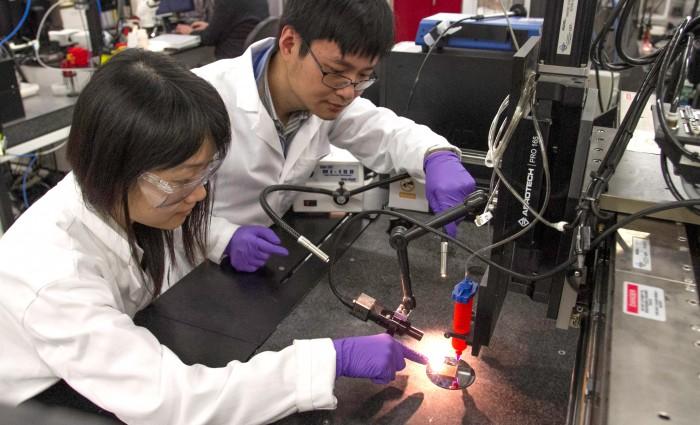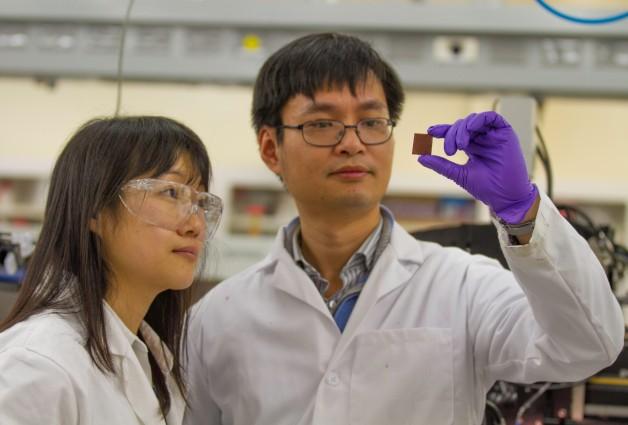LLNL’s New Graphene Bio-Ink Creates MicroArchitectures Allowing for New & Sleeker Electronics that Charge Super Fast
 Thanks to the power of numerous brilliant minds at LLNL, we are seeing yet another absolutely spectacular evolution in 3D printing. Teaming up with UC Santa Cruz, the researchers have just released the results of a project involving the creation of a very relevant energy source—after all, what’s more important these days than powering up our cell phones in an easier, more efficient way?
Thanks to the power of numerous brilliant minds at LLNL, we are seeing yet another absolutely spectacular evolution in 3D printing. Teaming up with UC Santa Cruz, the researchers have just released the results of a project involving the creation of a very relevant energy source—after all, what’s more important these days than powering up our cell phones in an easier, more efficient way?
In the paper published last month in Nano Letters, ‘Supercapacitors Based on Three-Dimensional Hierarchical Graphene Aerogels with Periodic Macropores,’ authored by Cheng Zhu, Tianyu Liu, Fang Qian, T. Yong-Jin Han Eric B. Duoss, Joshua D. Kuntz, Christopher M. Spadaccini, Marcus A. Worsley, and Yat Li, the teams explain that they’ve been able to use graphene for some very interesting new contemporary applications.
Employing the 3D printer for direct-ink writing with a graphene-oxide composite ink made specifically for the project at LLNL, the scientists were able to make ‘micro-architected electrodes’ to build supercapacitators which retain the type of energy sources much desired for the needs of consumers today—on par with similar electrodes but with the potential to be exponentially thinner, to the tune of 10 to 100 times.“This breaks through the limitations of what 2D manufacturing can do,” said engineer Cheng Zhu, the paper’s lead author. “We can fabricate a large range of 3D architectures. In a phone (for instance) you would only need to leave a small area for energy storage. The geometry can be very complex.”
Not only would they be able to feature an ultra-lightweight design for electronics, but these supercapacitors are also capable of charging ‘incredibly fast.’ While this may be a matter of a few minutes or seconds, either way that’s a huge improvement on the challenges we face currently in this battery-enslaved culture.
“The key factor in developing these novel aerogels is creating an extrudable graphene oxide-based composite ink and modifying the 3D printing method to accommodate aerogel processing. The 3D-printed graphene composite aerogel (3D-GCA) electrodes are lightweight, highly conductive, and exhibit excellent electrochemical properties,” state the researchers in their paper.
The teams see these innovative new 3D printed supercapacitors being used not just in existing designs that we are used to but also as a catalyst for allowing for unique electronics that would not be feasible without these new processes in combination with 3D printing. The scientists state that this could include paper-based or foldable devices, as well as customized smartphones that offer performance on a level we have yet to imagine.
“We’re pioneering the marriage of 3D-printing and porous materials,” said material and biomedical scientist Fang Qian, a co-author on the paper. “Think of a supercapacitor as a portable energy device, so anything that needs electricity would benefit from such a supercapacitor. If we can replace the standard (technology) with our lightweight, compact and high-performance supercapacitor, that would be a radical change.”

LLNL material and biomedical scientist Fang Qian (left) and engineer Cheng Zhu demonstrate a direct ink writing 3D printer they used to manufacture supercapacitors out of a graphene-based aerogel. [Photo: Julie Russell/LLNL]
- Ultrahigh surface area
- Lightweight properties
- Elasticity
- Superior electrical conductivity
- Extreme stability, retaining energy capacity after 10,000 consecutive charging and discharging cycles
The LLNL researchers worked very closely with UC Santa Cruz professor Yat Li and grad student Tianyu Liu, who performed the electrochemical characterizations and optimized the materials used in the process.
“Additively manufactured 3D architectures for energy storage will improve energy and power characteristics for supercapacitors, enabling lightweight, miniaturized power sources,” said LLNL materials engineer Eric Duoss. “Graphene is a really incredible material because it is essentially a single atomic layer that can be created from graphite. Because of its structure and crystalline arrangement, it has really phenomenal capabilities.”
The researchers see this as a huge step toward the future, and not surprisingly, they predict that we will see much more progress soon. As this year moves forward, they plan to develop new 3D designs with a range of different inks, exploring ways to improve the performance of these materials even further. Discuss this new technology in the LLNL Graphene Bio-ink forum over at 3DPB.com.
Funding for the research came from the internal Laboratory Directed Research & Development (LDRD).
[Source: LLNL]Subscribe to Our Email Newsletter
Stay up-to-date on all the latest news from the 3D printing industry and receive information and offers from third party vendors.
You May Also Like
NSF Awards Kentucky $1M for Advanced Manufacturing
The National Science Foundation has awarded a $1 million grant to the University of Louisville for the Advancing Manufacturing and Building Construction Technologies (NSF AMT) project. This initiative is part...
3D Printing News Briefs, May 11, 2024: 3D Printed Stent, Tower, Sculptures, & More
We’re starting off with medical research in today’s 3D Printing News Briefs, as researchers in Korea used CT images and 3D printing to fabricate an educational simulator for a mastoidectomy....
3D Printing Unpeeled: Wind Turbines, Probiotics and Lenses
TPI Composites, ORNL and Ingersoll Rand are working to make wind turbine tooling segments that can be 18.3 meters long. These elements also include resistive wires that help keep the...
Tethon 3D Releases Cost-effective Bioprinter
Tethon 3D, known for its ceramic-loaded DLP materials, custom resins, and DLP 3D printers, has recently released a bioprinter. Vat polymerization printers like DLP systems have been widely used by...

































